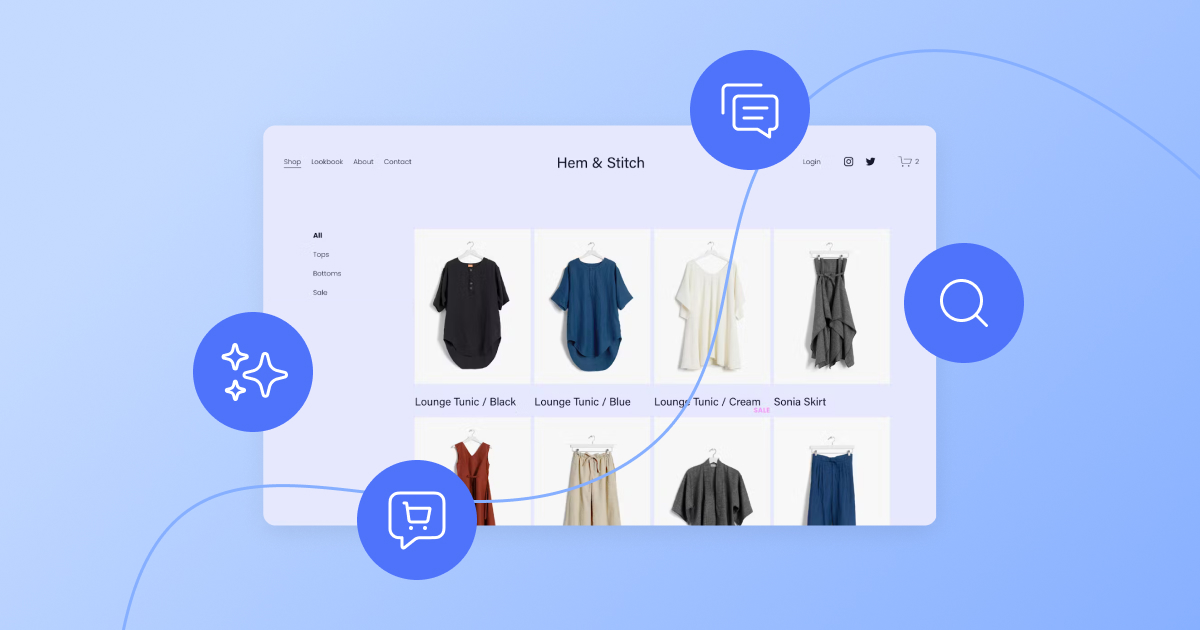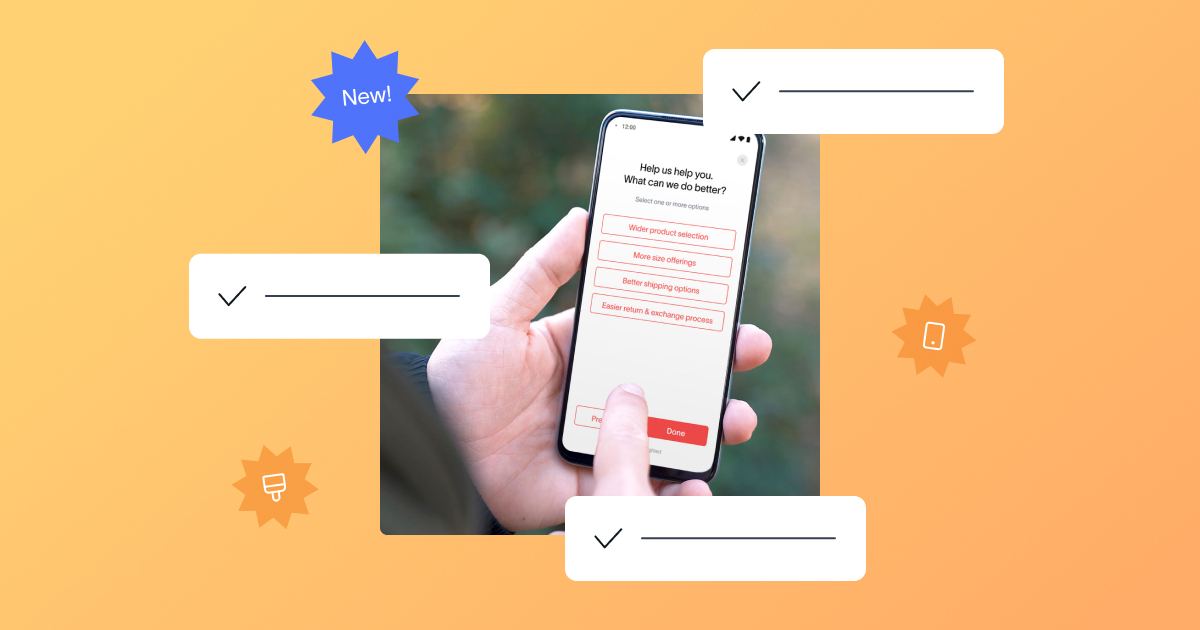Natively digital, ecommerce offers a brand fluidity that a purely brick-and-mortar business cannot. By 2027, nearly a quarter of retail purchases are expected to take place online. But while ecommerce has made retail purchases more accessible, it has also disrupted the traditional, linear, retail buyer’s journey and has transformed it into a more complicated series of customer touchpoints.
Mapping these touchpoints is crucial to understanding the ecommerce customer journey – and improving customer experiences. Leveraging tools that collect customer insights and data, ecommerce brands can readily gather the information they need to better serve their customers.
Not sure where or how to get started? In this guide, you’ll learn:
- What is the ecommerce customer journey?
- Why is the ecommerce customer journey important?
- 7 stages of the ecommerce customer journey
- How to learn about your customers across the ecommerce customer journey
What is the ecommerce customer journey?
The ecommerce customer journey maps the complete end-to-end experience of an online shopper’s path with your business. Beginning at the awareness stage, where the customer first learns about your brand, and culminating with the purchase decision, the ecommerce journey tells the story of how customers interact with your product. Enhancing each stage of the ecommerce customer journey can help increase conversion and engagement across your customer base.
Why is the ecommerce customer journey important?
From memorable interactions to disappointing experiences, customers formulate opinions of your brand at each touchpoint along the customer journey. Those opinions determine whether they purchase from you or take their business to a competitor. And trust us, you want that business: Statista estimates that revenue in the U.S. ecommerce market will see a $475 billion increase by 2028.
By creating an ecommerce customer journey map, you can pinpoint what’s working (and what’s not), take action to remove any friction, and ensure a smooth, holistic experience for your customers.
7 stages of the ecommerce customer journey
While each customer’s experience with your brand is unique, there are certain ecommerce journey stages a customer will go through to become a loyal customer:
Let’s take a closer look at each stage.
1. Awareness
Customers can become aware of your brand in a variety of ways, including word-of-mouth referrals, search engine results, paid advertising, or influencer endorsements on social media – in fact, an estimated 106.8 million people shopped on social media alone last year.
In the awareness stage, you’ve captured their interest and your brand is now on their radar.
2. Consideration
The next stage is consideration. This is when customers, having learned more about your product or service via your website, consider whether you meet their needs or not. Customers might compare you to competitors, or ask friends or family for their opinions on your brand.
3. Decision
Now that they’ve done their research, customers are ready to decide if they want to move forward with your product or service. At this stage, they’re adding to their cart – but they haven’t clicked purchase quite yet.
One important factor that weighs on consumers at this stage? Shipping. More than half of customers say free shipping is the top reason they shop online. If a brand doesn’t offer it, customers are prone to abandon their cart.
4. Purchase
At this stage, customers have completed their online order, received a confirmation email from you, and will (soon) start tracking their shipment.
You might think your job here is done – the customer became aware of your product or service, considered their options, decided yours was the right fit, and clicked buy on your website. However, retaining customers is just as important as acquiring them in the first place.
5. Retention
Now that you’ve earned a customer’s business, the next step is to retain them. Once a customer receives their product or service, this is the time to ask about their experience and satisfaction. Hearing from you – and being asked to share their feedback – can help foster trust and loyalty with customers.
With the feedback from your customers, you uncover how to retain them: whether that be by resolving their issues, removing pain points, or otherwise ensuring a seamless experience with your brand.
How much do customer retention and loyalty matter? They matter a lot, with 43% of customers spending more on brands that they are loyal to.
6. Engagement
At the engagement stage, the goal is to keep the customer relationship going. You can do this by reaching out to customers with email newsletters and content relevant to their interests or past purchases, coupons or discounts, or other incentives.
You can also engage them in audience research surveys, a tool that will help keep your brand top of mind while also garnering important insights about them as customers.
7. Advocacy
The final stage of the ecommerce customer journey is advocacy. When customers reach this stage, they’re loyal fans of your brand and actively telling whoever they can – friends, family, social media followers, and so on – about how much they love your product or service.
TIP: Brand advocates are a powerful influence, so be sure to demonstrate how much you value this caliber of customers. Loyalty programs are a great place to start.
How to learn about your customers across the ecommerce customer journey
Now that we’ve covered the 7 stages of the customer journey, let’s take a closer look at how to gather insights about your customers at each stage.
1. Ask customers how they found out about you during the awareness stage
Find out how customers were exposed to your brand by surveying them, and use those insights to inform and increase ROI for your marketing campaigns.
These surveys enable you to ask questions like:
- What is your initial reaction to the ad?
- How would you rate the ad?
You can also send a How Did You Hear About Us? survey to discover how customers found your product with an industry-leading attribution survey methodology.
2. Capture customer sentiment during the consideration stage
Using an online shopping survey, you can collect data to understand how your customers feel about your online shopping experience.
These surveys allow you to ask questions like:
- Did we make it easy to find what you’re looking for?
- Were you able to find all the information you need about the product?
- Were you able to find the product you were looking for?
- How satisfied were you with our online shopping experience?
- How would you rate the ease of using our site?
- Did you encounter any error or issues when purchasing via our site?
- Share any feedback on how we can improve our online shopping experience.
Here’s why getting the online shopping experience right matters: 91% of consumers make online purchases on their phone. That means both your desktop and mobile sites need to be as user-friendly as possible. Asking for customer feedback helps ensure that customers have an easy, frictionless experience no matter where they shop.
3. Find out how to reduce cart abandonment at the decision stage
Nearly half (47%) of online shoppers abandon their cart when they see additional costs crop up – like extra fees, shipping, and taxes – during the checkout process. With a cart abandonment survey, you can understand why your customers are abandoning their carts and use their feedback to improve their experience.
These surveys enable you to ask questions like:
- What’s keeping you from making a purchase?
- We noticed you left a few items in your cart. Can you tell us why?
4. Use post-purchase surveys to capture satisfaction and improve conversion rates at the purchase stage
Post-purchase surveys allow you to measure your online shopping experience and use feedback to enhance satisfaction and ease of use. You can also find out what your customers think of their recent purchase, including the product they chose and its usage, with a post-purchase satisfaction survey.
These surveys enable you to ask questions like:
- How easy was it for you to check out?
- Which product did you recently purchase with us?
- What was the main factor for deciding on that product?
- How often will you use the product you just bought?
- What are you most looking forward to regarding the product you just purchased?
- What problem does this product help you solve?
- What led you to choosing our brand over other options you were considering?
- Did your expectation of our product/service match the reality?
- How satisfied are you with the delivery timing?
- How would you rate the quality of that product?
- Overall, how satisfied are you with the product you purchased?
5. Collect NPS and CSAT survey feedback during the retention stage
At the retention stage, you can collect Net Promoter Score (NPS) survey data to measure customer loyalty. You can also use Customer Satisfaction (CSAT) surveys to find out if your delivery, return, or customer service experience satisfied customers.
These surveys enable you to ask the questions:
- How likely are you to recommend [company] to a [friend or colleague]?
- How satisfied were you with [company]?
TIP: Get the most out of your ecommerce customer survey program by leveraging our top ecommerce integrations. Trigger post-delivery surveys via Shopify, sync Delighted feedback to customer profiles in Gladly, HubSpot, Salesforce, and so much more.
6. Discover how to improve customer service through post-support feedback
A post-support feedback survey helps you track customer sentiment following support interactions. These surveys enable you to ask questions like:
- What issue were you hoping to get addressed today?
- How easy was it for you to return your purchase?
- How satisfied are you with the resolution of your issue?
The insights you receive from post-support feedback surveys highlight customer pain points so you can close the loop on their issue and improve future experiences.
7. Conduct audience outreach and marketing research to boost engagement
Learn how customers use and feel about your product or service with a customer feedback survey. These surveys enable you to ask questions like:
- How often do you use our product or service?
- How satisfied are you with the overall quality of the product or service?
- What is your favorite part of the product or service?
- How can we improve your experience?
- What other products would you like to see from us?
TIP: Embed email surveys in your marketing automation platform to continuously generate insights and boost engagement. Learn more about the embed platform.
8. Measure loyalty during the advocacy stage
To measure customer loyalty and understand repeat purchase intent during the advocacy stage, ask the NPS question: How likely are you to recommend [company] to a [friend or colleague]?
Understanding who the promoters, passives, and detractors are in your customer base can help you hone in on the loyal customers who go out of their way to follow your brand and recommend your products or services.
But you also want to pay attention to your other customer segments. While promoters are more likely to stick with you for the long haul, detractors are more likely to churn or spread negative word-of-mouth, and passive customers could go either way. The NPS data you collect helps you identify all types of existing customers so you can follow up with them to improve customer experiences.
TIP: With Delighted Autopilot, you can automatically send surveys out over a period of time for a constant stream of feedback, and make sure no one is ever over-surveyed.
With knowledge of how the customer journey changes in the world of ecommerce, you can optimize each touchpoint for superb customer experience. Why wait? Start surveying customers in minutes with our free ecommerce survey templates and gather valuable insights.






